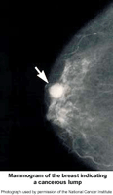What is a mammogram?
A mammogram is a low-dose X-ray examination of the breast. It is used to detect and diagnose breast disease in women who have breast problems such as a lump, pain or nipple discharge, as well as for women who have no breast concerns.
Mammography cannot prove that an abnormal area is cancer, but if it raises a significant suspicion of cancer, further investigation with ultrasound may be needed, and / or tissue will be removed for a biopsy. Tissue may be removed by needle or open surgical biopsy and examined under a microscope to determine if it is cancer.
Mammography has been used routinely for about 30 years, and in the past 15 years technical advancements, and special training of radiologists and technologists, have greatly improved both the technique and results. Today, dedicated equipment used only for breast X-rays produce images that are high in quality but low in radiation dose. Radiation risks are considered to be negligible compared to the benefits of early detection.
There are two forms of mammograms, depending on the purpose:
- Screening mammogram: A screening mammogram is an X-ray of the breast used to detect breast changes in women who have no signs of breast cancer. It usually involves two X-rays of each breast – a side-to-side and a top-to-bottom view. Using a mammogram, it is possible to detect a tumor that cannot be felt.
- Diagnostic mammogram: A diagnostic mammogram is an X-ray of the breast used to diagnose unusual potentially abnormal breast changes, such as a lump, pain, nipple thickening or discharge or a change in breast size or shape. A diagnostic mammogram also is used to evaluate abnormalities detected on a screening mammogram. It is a basic medical tool and is appropriate in the workup of breast changes, particularly in women over 30.
Digital mammography technology has been around for about 15 years and has improved breast imaging. Digital mammography provides electronic images of the breasts that can be enhanced by computer technology, stored on computers and even transmitted electronically in situations where remote access to the mammogram is required.
How is mammography performed?
X-rays of the breast are different than those used for other parts of the body. The breast X-ray does not penetrate tissue as easily as the X-ray used for routine X-rays of other parts of the body. The breast is compressed by the mammogram equipment to spread the tissue apart. This procedure allows for a lower dose of radiation and less tissue overlap, which makes for better image quality. Compression of the breast may cause temporary discomfort, but is necessary to produce a good mammogram. The compression only lasts for a few seconds for each image of the breast. A breast X-ray technologist usually takes the X-rays, but the resulting films are read and interpreted by a radiologist, who reports the results to your clinician.
What conditions does a mammogram show?
Calcifications, tiny mineral deposits within the breast tissue. These appear as bright white specks or areas on the mammogram.

There are two categories of calcifications:
- Macrocalcifications– coarse calcium deposits that usually indicate benign or degenerative (non-cancerous) changes in the breasts, such as:
- aging of the breast arteries - similar to cholesterol/plaque build-up causing thickening of arteries of the heart or legs
- hormonal changes as women get older
- scar tissue (from old injuries or surgery)
- Microcalcifications – tiny (less than 1/50 of an inch) specks of calcium; when many microcalcifications are seen in one area, they are referred to as a group
- These have both cancerous and non-cancerous causes, and so may need to be further evaluated on additional imaging and/or biopsy
Masses, which may occur with or without associated calcifications, and may be due to different causes, including:
- Cyst – a noncancerous collection of fluid in the breast; it cannot be diagnosed by physical exam alone nor by mammography alone. Either breast ultrasound or rarely aspiration with a needle is required. If a mass is not a cyst, that is, if it is a solid “lump,” then further workup or follow up may be obtained.
- Benign breast conditions – masses that are unlikely to be cancerous based on how they look on imaging, and therefore can be monitored with periodic mammography or ultrasound, but others may require immediate or delayed biopsy.
Breast Cancer
What are the guidelines for having a mammogram?
The guidelines for screening mammography are controversial. For example, this chart lists the recommendations from various groups.
Despite the confusion, there is an overwhelming amount of scientific evidence showing that mammograms save the most lives when done yearly starting at age 40 (or earlier in patients with certain risk factors).
Multiple studies done around the world, some with up to 40 years of patient follow-up, demonstrate up to 40% decrease in deaths from breast cancer when following this guideline. This is why VCU Breast Imaging follows this recommendation.
The other groups agree with these numbers, but also weigh in the potential down-sides of mammograms, such as associated fear and anxiety, false alarms (false positives), use of radiation, and potential complications from breast biopsies. These are certainly important issues to consider, and fix, however, they don’t come anywhere close to the number of lives saved, and likelihood of needing less aggressive treatments, through early detection with yearly screening.
Frequently asked questions about mammography
What is the benefit?
Early detection of breast cancer not only helps provide a woman with more treatment options, but also increases the possibility of a favorable outcome. The earlier a cancer is caught, the smaller it is likely to be, and therefore easier to treat with a higher chance of survival.
Is there a risk of radiation exposure from having regular mammograms?
The amount of radiation and potential harm from a mammogram is extremely small. The U.S. Food and Drug Administration regulates that mammograms not exceed two rads (radiation absorbed dose), the unit of measure for radiation exposure. Most mammograms actually deliver a fraction of that amount. In fact, the dose of a mammogram is also just a fraction of the amount of radiation we are exposed every year from our environment – rocks, soil, sunlight, etc, and there is no evidence that mammograms cause cancer. Therefore, the benefits of early detection are thought to far outweigh the risk from radiation.
What should a woman expect when having a mammogram?
A woman should avoid using deodorant, powder, and lotions on the day of the mammogram. These can leave residue on the skin that could mimic calcifications, and therefore cause a false alarm and unnecessary follow up.
We recommend wearing a two-piece outfit on the day of the mammogram. After changing into a gown, a specially trained radiological technologist, who will perform the X-ray, will ask the woman to undress at the top, and stand next to the X-ray machine. Two flat surfaces, or plates, are lowered and compress each breast for a few seconds. This compression is necessary to produce the best pictures using the lowest amount of radiation possible.
The technologist will check the images for technical quality – for example, sharpness, and making sure as much breast tissue is included in the image as possible, and then the mammogram will be interpreted (“read”) by a radiologist. This is a physician who is specially trained in radiology. If the mammogram is normal, the doctor will send the patient and her clinician a report. If the radiologist sees a change, or possible abnormal area, the patient will be asked to return for diagnostic imaging for further evaluation, and the patient will get results from that diagnostic workup the same day. It is important to remember that not all changes on mammograms are due to cancer. The vast majority of what radiologists find on imaging is benign (not cancer), often due to hormonal or fibrocystic changes.
Are mammograms painful?
Some women find the pressure of the plates on their breasts to be uncomfortable or even somewhat painful. Timing your mammogram when your breasts are not tender is important. In premenopausal women, this is usually 7-10 days after the first day of your menstrual period. If you do experience discomfort or pain, remember that each X-ray takes just a few moments and could save your life.
Who pays for mammography?
Medicare covers mammography screening for women 65 and older every year. Most states now require that health insurance policies offer mammography screening reimbursement. In addition, many mammography facilities also offer special programs and lower fees during National Breast Cancer Awareness Month in October.


